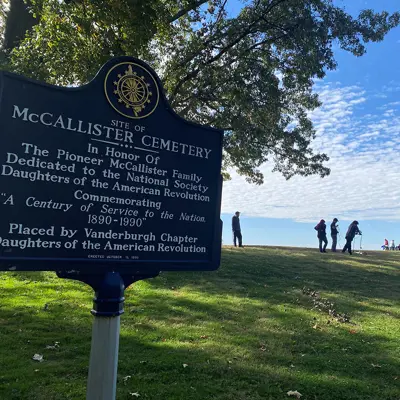
A look into the past
USI anthropology professor, students help locate graves in Wesselman Park
October 25, 2022
Though there was a bit of a chill in the air, the sun was shining bright on Saturday, October 15 at Wesselman Park. Curious walkers and runners made their way past the former Par 3 Golf Course, where a small group congregated.
Among this group are Mike Strezewski, Associate Professor of Anthropology, and three of his students. They were asked to the area—the location of the McCallister Cemetery—by Cheri Baumberger, Honorary Regent of the Evansville Chapter of the Daughters of the American Revolution (DAR) and co-chair of the McCallister Pioneer Cemetery Committee, to help uncover the location of graves.
 Anyone who has visited the area of the park has seen the historical marker, erected by DAR in 1990. It states, “Site of McCallister Cemetery. In honor of the pioneer McCallister family. Dedicated to the National Society Daughters of the American Revolution commemorating ‘A century of service to the nation. 1890-1990' Placed by Vanderburgh Chapter Daughters of the American Revolution.”
Anyone who has visited the area of the park has seen the historical marker, erected by DAR in 1990. It states, “Site of McCallister Cemetery. In honor of the pioneer McCallister family. Dedicated to the National Society Daughters of the American Revolution commemorating ‘A century of service to the nation. 1890-1990' Placed by Vanderburgh Chapter Daughters of the American Revolution.”
“The burials at the site likely date to the 1810s at the very earliest,” says Strezewski.
Baumberger and DAR have been working on uncovering the location of former grave sites since October 2020. According to the information available, gravestones from the plots have been missing since the 1960s, and while records indicate the cemetery was one acre in total, there are no specific boundaries that have been found yet. The DAR chapter hopes to be able to uncover that along with the grave sites.
“We would like to put up some fencing around the area, similar to the split rail fence that once stood around the cemetery,” says Baumberger.
Back in June, the Evansville Park Commission provided DAR with permission to look for these sites and document their exact placement with the overall goal to have McCallister Cemetery placed on the National Register of Historic Places. The group recruited Evansville resident Mike Chappell in September to search the grounds and outline a total of 26 potential graves. It was then that the group called in Strezewski.
“I have done a number of similar cemetery projects in the past, most recently at a historical African American cemetery in 2021. This is the fourth historic cemetery survey I’ve done in southwestern Indiana,” says Strezewski.
 He and his students started their work with a resistivity meter. This device injects electrical current into the ground to detect soil disturbances, which Strezewski says could indicate where grave sites are located. Another instrument his group utilized was a magnetometer. This device detects magnetic anomalies beneath the surface which can be caused by disturbance of soil, the presence of iron or burning.
He and his students started their work with a resistivity meter. This device injects electrical current into the ground to detect soil disturbances, which Strezewski says could indicate where grave sites are located. Another instrument his group utilized was a magnetometer. This device detects magnetic anomalies beneath the surface which can be caused by disturbance of soil, the presence of iron or burning.
On October 15, the group started its work with the resistivity meter, injecting it into the ground for a reading. They worked into rows, moving through the space the DAR group marked off. This work wasn’t just about lending a hand to the DAR’s work, but it also was useful in giving Strezewski’s students a chance to step outside the classroom setting with the equipment and experience how fieldwork occurs.
“It’s one thing to talk about the instruments in class, it’s a whole other matter to actually get to use them and see how they work in the field,” says Strezewski. “I try to include students as much as possible in projects like this one in order to give them real-world experience.”
 Once the data from the instruments is gathered and processed for DAR, Baumberger and fellow chapter members will move forward in working to place markers and fencing to help preserve the space, which is the final resting place of an early pioneer family of Evansville. It’s that important point that also makes the volunteer work worth it for Strezewski and his students.
Once the data from the instruments is gathered and processed for DAR, Baumberger and fellow chapter members will move forward in working to place markers and fencing to help preserve the space, which is the final resting place of an early pioneer family of Evansville. It’s that important point that also makes the volunteer work worth it for Strezewski and his students.
“I’m always glad to collaborate with local groups that are interested in preserving local history,” he says. “It’s important we all know about our past and help to preserve sites related to that past.”